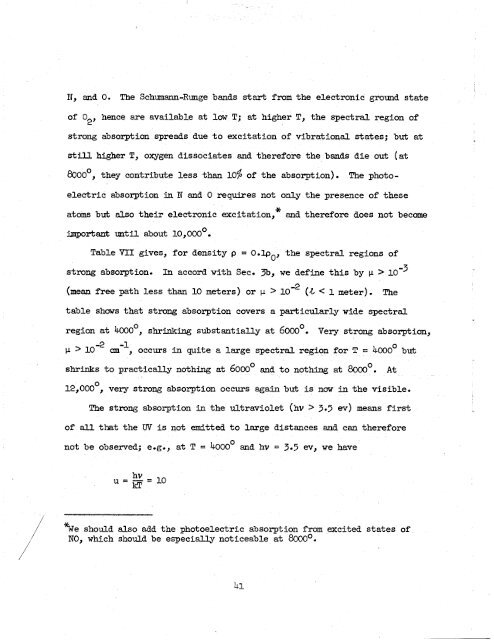Theory of the Fireball
Theory of the Fireball
Theory of the Fireball
Create successful ePaper yourself
Turn your PDF publications into a flip-book with our unique Google optimized e-Paper software.
N, and 0. The Schumann-Runge bands start from <strong>the</strong> electronic ground state<br />
<strong>of</strong> 02, hence are available at law T; at higher T, <strong>the</strong> spectral region <strong>of</strong><br />
strong absorption spreads due to excitation <strong>of</strong> vibrational states; but at<br />
still higher T, oxygen dissociates and <strong>the</strong>refore <strong>the</strong> bands die out (at<br />
&looo, <strong>the</strong>y contribute less than lO$ <strong>of</strong> <strong>the</strong> absorption). The photo-<br />
electric absorption in N and 0 requires not only <strong>the</strong> presence <strong>of</strong> <strong>the</strong>se<br />
atoms but also <strong>the</strong>ir electronic excitation, and <strong>the</strong>refore does not become<br />
importast until about 10,OOOo.<br />
Table VI1 gives, for density p = O.lpO, <strong>the</strong> spectral regions <strong>of</strong><br />
strong absorption. In accord with Sec. 3b, we define this by p > lom3<br />
(mean free path less than 10 meters) or I-L > lom2 (4 1 meter). The<br />
table shows that strong absorption covers a particularly wide spectral<br />
region at 4000°, shrinking substantially at 6000~. Very strong absorption,<br />
p > LOm2 m-', occurs in quite a lwge spectral. region for T = 4000° but<br />
shrinks to practically nothing at 6000~ and to nothing at 8000°. At<br />
12,000°, very strong absorption occurs again but is now in <strong>the</strong> visible.<br />
The strong absorption in <strong>the</strong> ultraviolet (hv > 3.5 w) means first<br />
<strong>of</strong> all that <strong>the</strong> W is not emitted to large distances and can <strong>the</strong>refore<br />
0<br />
not be observed; e.g., at T = 4000 and hv = 3.5 ev, we have<br />
%e should also add <strong>the</strong> photoelectric absorption from excited states <strong>of</strong><br />
NO, which should be especially noticeable at 8000°.<br />
41<br />
JC.
















